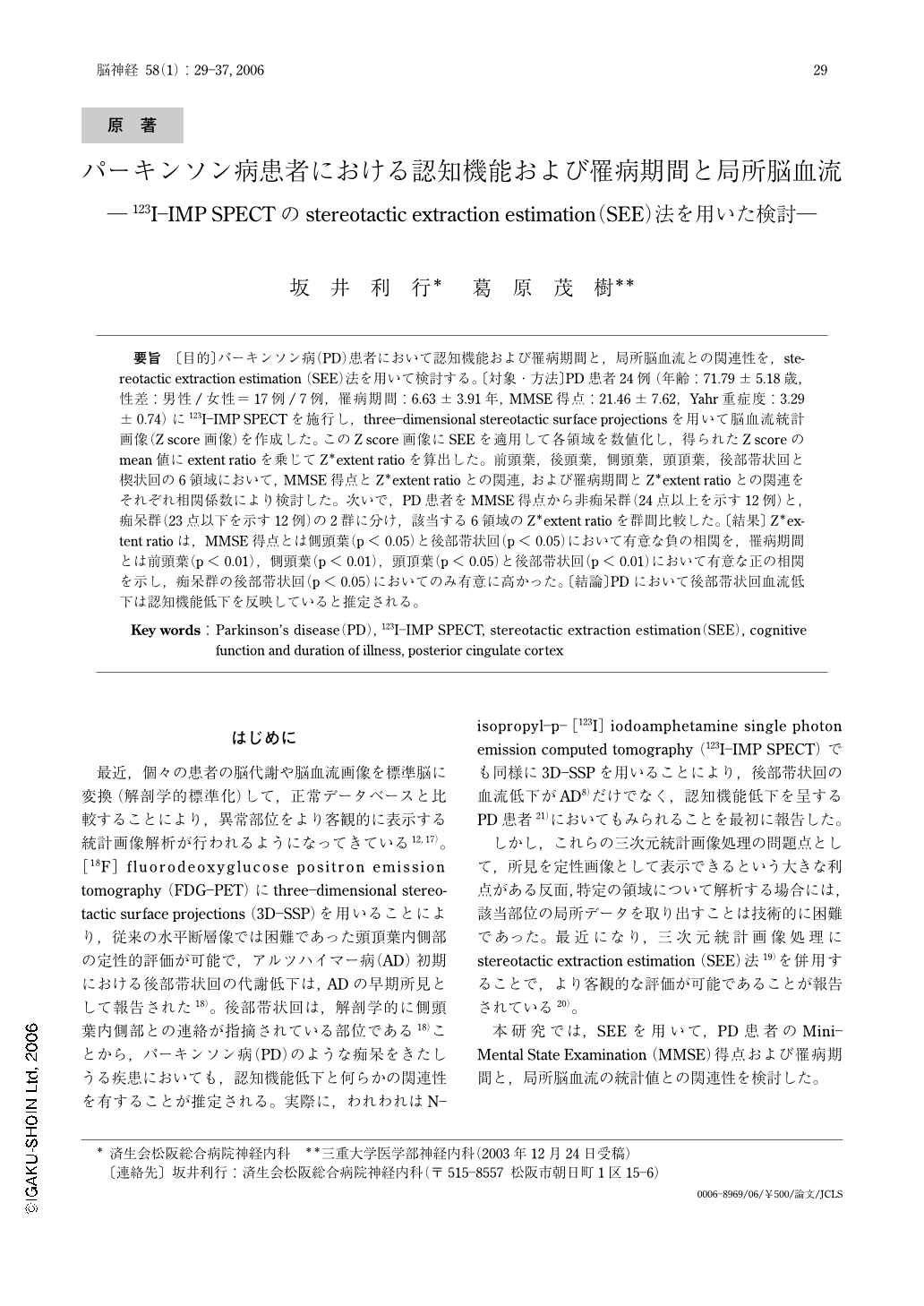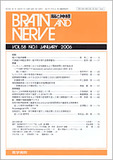Japanese
English
- 有料閲覧
- Abstract 文献概要
- 1ページ目 Look Inside
- 参考文献 Reference
〔目的〕パーキンソン病(PD)患者において認知機能および罹病期間と,局所脳血流との関連性を,stereotactic extraction estimation (SEE)法を用いて検討する。〔対象・方法〕PD患者24例 (年齢:71.79±5.18歳,性差:男性 / 女性=17例 / 7例,罹病期間:6.63±3.91年, MMSE得点:21.46±7.62,Yahr重症度:3.29±0.74) に123I-IMP SPECTを施行し,three-dimensional stereotactic surface projectionsを用いて脳血流統計画像(Z score 画像)を作成した。 このZ score 画像にSEEを適用して各領域を数値化し,得られたZ scoreのmean値にextent ratioを乗じてZ*extent ratioを算出した。前頭葉,後頭葉,側頭葉,頭頂葉,後部帯状回と楔状回の6領域において, MMSE得点とZ*extent ratioとの関連, および罹病期間とZ*extent ratioとの関連をそれぞれ相関係数により検討した。次いで,PD 患者をMMSE得点から非痴呆群(24点以上を示す12例)と,痴呆群(23点以下を示す12例)の2群に分け,該当する6領域のZ*extent ratio を群間比較した。〔結果〕 Z*extent ratioは,MMSE得点とは側頭葉(p<0.05)と後部帯状回(p<0.05)において有意な負の相関を,罹病期間とは前頭葉(p<0.01),側頭葉(p<0.01),頭頂葉(p<0.05)と後部帯状回(p<0.01)において有意な正の相関を示し,痴呆群の後部帯状回(p<0.05)においてのみ有意に高かった。〔結論〕PDにおいて後部帯状回血流低下は認知機能低下を反映していると推定される。
Objective : To investigate the correlation of the cognitive function and the duration of the illness with the regional cerebral blood flow (rCBF) in patients with Parkinson's disease (PD), by means of an objective diagnostic index of brain imaging, stereotactic extraction estimation (SEE) of 123I-IMP SPECT. Patients and methods : We examined 123I-IMP SPECT in 24 patients with PD (age=71.79±5.18 years; the Mini-Mental State Examination : MMSE score=21.46±7.62 points; the duration of the illness=6.63±3.91 years ; Yahr scale=3.29±0.74). A contrast database was created by averaging extracted database sets of the contrast group (numbers=14 cases ; age=74.64±5.99 years, the MMSE score≧29 points). We applied SEE for Z-score images of three-dimensional stereotactic surface projection analysis (3D-SSP) for 123I-IMP SPECT, and calculated Z*extent ratio by taking advantage of severity of Z-score (the mean value) with extent ratio (%) in the frontal, occipital, temporal, parietal and posterior cingulate cortices, and precuneus, respectively. We investigated the correlation coefficient between the MMSE score and Z*extent ratio, and between the duration of the illness and Z*extent ratio in the six regions. In addition, we compared Z*extent ratio in the six regions between the non-demented group (numbers=12 patients ; MMSE≧24 points) and the demented group (numbers=12 patients ; E score≦23 points). Results : There were negative correlations between the MMSE score and Z*extent ratio in the temporal(p<0.05) and posterior cingulate cortices(p<0.05), and positive correlations between the duration of the illness and Z*extent ratio in the frontal(p<0.01), temporal(p<0.01), parietal(p<0.05) and posterior cingulate cortices(p<0.01). Z*extent ratio was significantly high only in the posterior cingulate cortex(p<0.05) in the demented group. Conclusions : SEE for Z-score images of 3D-SSP revealed a close relationship between the decline of the MMSE score and the duration of the illness, and the perfusion reduction of the posterior cingulate cortex in patients with PD. These findings suggest that the perfusion reduction of the posterior cingulate cortex reflects the decline of cognitive impairment of patients with PD.
(Received : December 24, 2003)

Copyright © 2006, Igaku-Shoin Ltd. All rights reserved.


